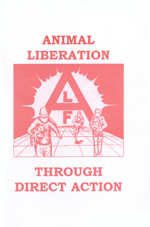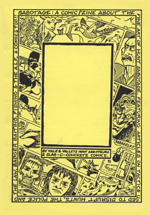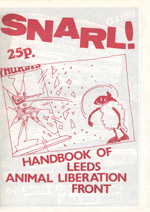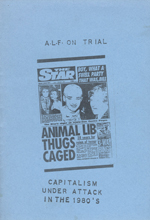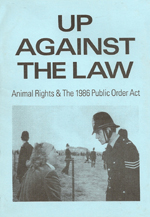Category
One-off publications
-
Audio / Music, One-off publications
Still Angry?
Still Angry? The Compilation Tape and Fanzine: A Benefit for the Toronto ALFSG (1987, Toronto, Canada)
The Toronto ALFSG released many of the publications on this site and were one of the best sources of information on direct action for non-humans in the 1980s. In order to financially support their work, they released this cassette and zine compilation in 1987. After searching for it since the start of TALON, we finally found a copy just a few short months ago.
Hailing primarily from Europe, North America, and South Africa, the bands on this compilation run the gamut of punk sub-genres and fans of fast, loud music should find something they enjoy. The zine and liner notes are typical of their era- cut and paste style graphics, juvenile interviews, and plenty of righteous frustration with law and order.
Due to a file error, we currently only have Side A of the cassette digitized. Please accept our apologies, we will post the full cassette soon.
[soundcloud url=”https://api.soundcloud.com/playlists/163187882″ params=”auto_play=false&hide_related=false&show_comments=true&show_user=true&show_reposts=false&visual=true” width=”100%” height=”450″ iframe=”true” /]
…
-
One-off publications
Flamethrower
Flamethrower (1986. London, England)
We recently received this publication from another archivist but have very little information about its origins. Still, with a flame throwing, angry feminist on the cover how can you go wrong?
The interior pages are a pastiche of radical thoughts and images varying greatly in quality, but even in the paper’s more juvenile moments I sense the work of people sincerely concerned with creating a free society. How they thought rioting alone would get them there is another matter…
If you have any information about Flamethrower please contact us HERE.
…
-
One-off publications
Animal Liberation Through Direct Action
Animal Liberation Through Direct Action – (Date of publication unknown, likely 1998. Country of origin unknown, likely England)
Animal Liberation Through Direct Action was one of the better primers available in the 1990s. Designed for activists who had never before participated in illegal actions, the pamphlet discusses the basic security, surveillance, and planning necessary to carry out liberations and economic sabotage. It also includes a brief history of the movement, a first hand account of a mink farm raid, and statements from various ALF cells.
…
-
One-off publications
The ALF Is Watching And There’s No Place To Hide
The ALF Is Watching And There’s No Place To Hide – Zine / Album (1988 – Laguna Beach, CA)
This post was difficult to write, and several times I almost abandoned it. What was originally intended to be a short essay about the dangers of sub-culturization vs. the positives of spreading messages through music quickly became something else- a warning about bigotry and cult like behavior in the animals rights movement.
It all started when a friend told me he had tracked down a copy of the punk record that is the subject of this post, The ALF is Watching And There’s No Place To Hide. He sent over the audio tracks along with the zine insert. I knew little about the record, but something seemed familiar about label behind it: “No Masters Voice.” It didn’t take long to figure out that the imprint had been run by Sean Muttaqi, founder of the band Vegan Reich and originator of a dogmatically anti-gay, anti-abortion tendency within the animal rights movement known as Hardline.
I could write volumes about the right wing sectarian leanings that have cropped up in the movement over the years and am tempted to every time I encounter anything related to Vegan Reich. Instead, I’ll make it simple. In the 1980’s a friend of mine was being surveilled by the FBI, ATF, and private security companies. After an anarchist gathering that took place in Toronto, corporate spy group Perceptions International erroneously claimed that he had been seen attending workshops with Muttaqi. He wrote Sean a letter to give him a heads up about the situation. This is what he got in response:
“I can tell by the anarchist-pacifist-faggot symbol you signed your letter with that I will never become friends with you.”
So, in short, fuck Hardline and anyone who apologizes for it.
That said, there are some decent tracks on this record, including songs from bands like Chumbawamba, who are decidedly antithetical to the tenets of Hardline. The liner notes were written prior to Sean’s “Zen Shiite” nonsense and contain nothing about “deviant sexuality,” or a gun wielding vegan vanguard. Instead, essays about various forms of animal imprisonment and abuse are scattered among reprints from British ALF publications. Minus the link to a cult leader, this would be a decent record!
TALON is looking to occasionally archive animal liberation related themes in popular media and subcultures. If you have an obscurity along those lines, please contact us HERE.
…
-
One-off publications
Sabotage : A Comic / Zine About The Fine Art Of Hunt Sabotage
Sabotage : A Comic / Zine About The Fine Art Of Hunt Sabotage (1992 – Cardiff, UK)
Produced by the Vale and Valleys Hunt Sabs, this short zine provides exactly what the title suggests. The interior has articles and comics from a wide cross section of saboteur subcultures, from crusties to older folks in white tennis shoes. The quality of the content is all over the map as well, but still makes for an interesting look at sabbing culture and technique in the early 1990s.
…
-
One-off publications
The Animal Liberation Primer
The Animal Liberation Primer (publishing date unknown, location likely the United States)
Containing material mostly culled from other similarly named primers, this is a short how-to guide for small scale property damage, arson*, and liberations. It contains a basic run down of security measures, mental preparation, and history of the Animal Liberation Front. Although it was surely a good resource in its time, its value as a primer has diminished with the advent of new security technologies, legislation, and state-surveillance. Anyone looking to undertake direct action would do well to find a modern source of instruction.
*The United States government fears a public empowered with the means to confront the excesses of their corporate masters, and as such has banned the distribution of literature containing instructions to build destructive devices. You can still purchase a shotgun at Walmart, or a bomb manual on Amazon, but we must censor all instructions here on our site. We apologize to our readers for the impact this has on the completeness of our archive.
…
-
One-off publications
SHAC – A Campaign That Made History
SHAC – A Campaign That Made History (2013 – Italy)
I am happy to see that new generations of activists are discussing the successes and failures of the Stop Huntingdon Animal Cruelty campaign with an eye towards applying those lesson to the ongoing struggle for animal liberation. This attractive booklet was originally released in Italy under the name “SHAC: ha fatto storia” and focuses on the legal repression, past and present, experienced by those working to close Huntingdon Life Sciences. The english translation is not perfect, but makes for a good overview of the FBI’s “Operation Trailmix” in the US and INTERPOL’s “Operation Achilles” in Europe.
The collective that made this booklet has a blog at shacmadehistory.noblogs.org. I would love to see them continue to dissect the international repression against SHAC and also support the victims of the same.
…
-
One-off publications
SNARL! Handbook of the Leeds A.L.F.
SNARL! Handbook Of Leeds ALF (1985. Leeds, England)
One of the great things about punk music is also one of the worst things about it: anyone can do it. On the one hand this encourages kids to destroy the adulation of rockstars and to make music (as well as zines, clothes, art, etc) themselves. That accessibility has brought us the voices of people we never would have otherwise heard, which is wonderful. On the other hand, punk doesn’t exist in a vacuum, it came into being in a culture afflicted with bias and brutality, patriarchy, capitalism, and so on. Those elements are ingrained in many of the creators of punk and are, at times, reflected in the works they produce. Those messages are then carried on to those who consume that media.
It isn’t hard to make the leap from an analysis of punk to an analysis of leaderless resistance. Without a hierarchy or organized recruiting mechanism, the A.L.F. has often spread through the same means as punk rock- DIY media, the passion and anger of youth, and at times, sensationalized mainstream media stories. People have heard the call and picked and up the banner, acting on their own initiative to make change. The downside, of course, is that without a training component that goes beyond a few words in a zine about security culture, these newly active saboteurs aren’t always left with the skill set needed to safely or effectively undertake underground actions. They may end up making their own publications which repeat the mistakes of the ones they first read, and these will be passed on to the consumers of that media.
If I were 16 years old and living in Leeds in 1985, I would have loved SNARL. It speaks from a place of youthful (and righteous) rebelliousness, and although the tone can be a little dogmatic, nearly everything else about the “handbook” is just plain cool. I laughed out loud to see license plates, makes and models of undercover police vehicles listed, and was encouraged to see the inclusion of human liberation struggles. That said, the young folks who made this zine were reproducing some of the worst aspects of other publications from the era as far as security and theatrical militancy goes.
SNARL is an interesting product of it’s time, written and distributed by well meaning, hard-fighting folks who no doubt had the best interest of non-humans in their hearts. That said, I hope readers at the time were cautious in following the advice it contained, because much of it was outright dangerous. Looking at the prisoner listings from this period, that doesn’t seem to be the case.
…
-
One-off publications
A.L.F. On Trial – Capitalism Under Attack In The 1980’s
A.L.F. On Trial – Capitalism Under Attack In The 1980’s (1987. England, city of publication unknown.)
On February 5th of 1987 ten British animal liberationists were sentenced to an aggregate of 38 years after a trial prosecutors had designed to “break the back of the ALF.” This case, popularly referred to as the Sheffield Trial, set precedents not only in the UK, but worldwide for the manner in which vegan militants would be tried by the state and media.
Although the Sheffield Trial failed in its goal to end underground direct action for non-humans, it did take a serious toll on the movement. Ronnie Lee was sentenced to 10 years, Roger Yates skipped bail and went on the run, and several others were taken out of the struggle for lengthy periods. The negative media blitz during the trial was among the first to create a popular association between the terms “animal rights” and “terrorist.” Worst of all, Sheffield was the first case in which the charge of “Conspiracy to Commit Criminal Damage” was upheld, essentially allowing radical media producers (In this case Ronnie Lee and the SG Newsletters) to be held responsible for the actions of others the authors had never met or otherwise interacted with- in fact, these other “conspirators” didn’t even have to be known to the authorities. All that needed to be shown was that a publication showed approval for an illegal act and that those acts then continued to occur. (Other courts disagreed with this novel interpretation of the law however, most notably the appeals court in the GANDALF trial.)
Parallels between this case and that of the SHAC 7 and others are clear, but little has been done to learn from the earlier trial. Luckily, an anarchist analysis of the court proceedings from 1987 has survived in the form of this brief, snarky pamphlet.
…
-
One-off publications
Up Against The Law
Up Against The Law (1987 – London, England)
Long before the Animal Enterprise Terrorism Act or the advent of Ag-Gag laws, western governments were using other means to protect the profits of animal abusers. Through methods legislative and extra-legal, the British government was particularly skilled in disrupting the efforts of animal liberationists. By the late 1980s these attacks had become so commonplace and effective that J.J. Roberts (the collective pen name of John Page and Jane Holgate) of ARC Print (Publisher of the excellent Against All Odds) wrote Up Against the Law as an effort to give activists knowledge of repressive legislation and a means to fight back.
Up Against the Law is crucial reading for those who want to understand the history of public order laws, their use against activists, and how our movement has coped with past attacks on our abilities to protest.
…



